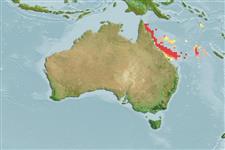Preferred temperature (Ref.
123201): 24.7 - 28.4, mean 26.7 °C (based on 408 cells).
Phylogenetic diversity index (Ref.
82804): PD
50 = 0.5000 [Uniqueness, from 0.5 = low to 2.0 = high].
Bayesian length-weight: a=0.00741 (0.00335 - 0.01640), b=3.02 (2.83 - 3.21), in cm total length, based on LWR estimates for this (Sub)family-body shape (Ref.
93245).
ระดับชั้นอาหาร (Ref.
69278): 2.0 ±0.00 se; based on food items.
ความสามารถในการกลับคืนสู่ปกติ (Ref.
120179): ความสูง, เวลาต่ำสุดที่จะทำให้ประชากรเพิ่มขึ้นเป็น 2 เท่าใช้เวลาน้อยกว่า 15 เดือน (Preliminary K or Fecundity.).
Fishing Vulnerability (Ref.
59153): Low vulnerability (10 of 100).
Nutrients (Ref.
124155): Calcium = 235 [112, 443] mg/100g; Iron = 1.08 [0.60, 1.97] mg/100g; Protein = 17.7 [16.5, 18.9] %; Omega3 = 0.0909 [, ] g/100g; Selenium = 26.5 [11.5, 63.6] μg/100g; VitaminA = 115 [27, 483] μg/100g; Zinc = 3.32 [2.11, 4.99] mg/100g (wet weight);
